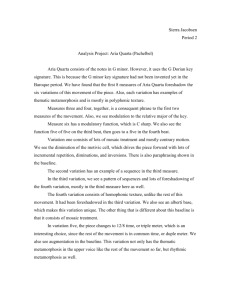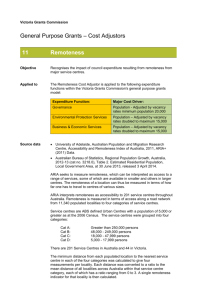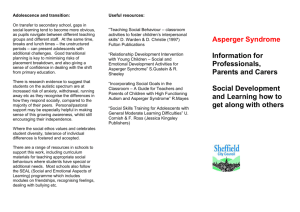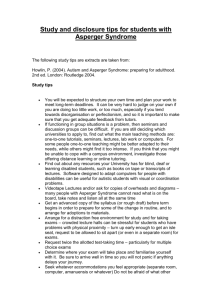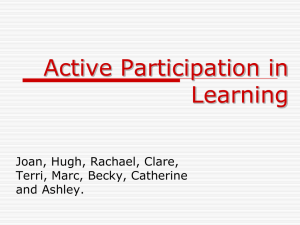Diagnosis - Penn State College of Education
advertisement
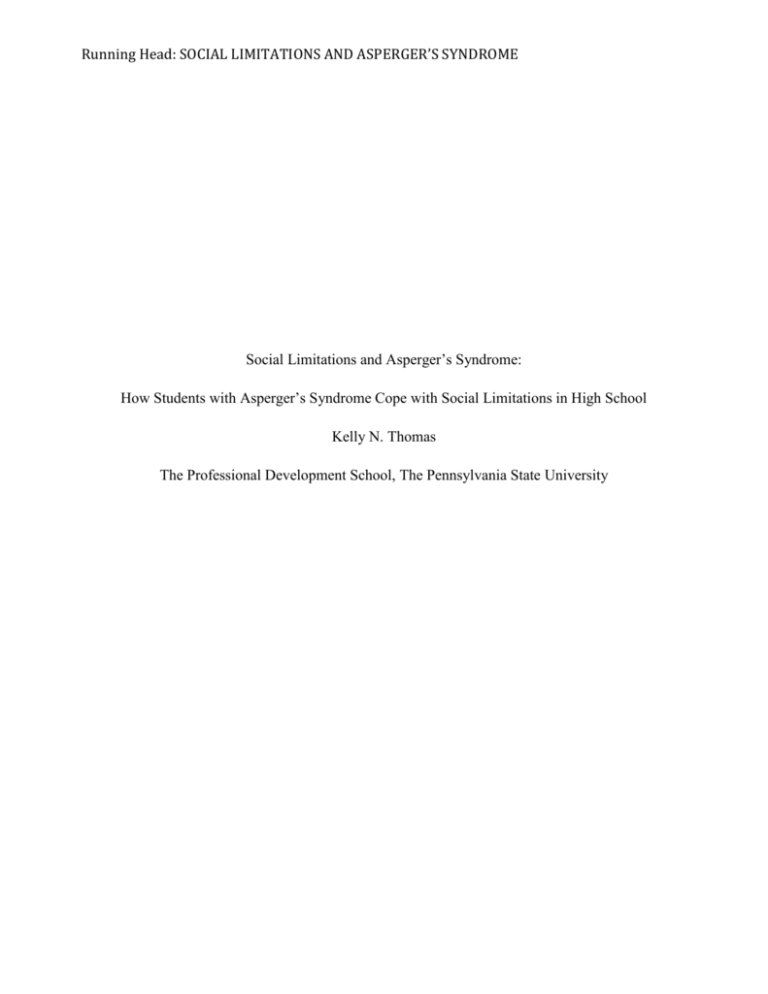
Running Head: SOCIAL LIMITATIONS AND ASPERGER’S SYNDROME Social Limitations and Asperger’s Syndrome: How Students with Asperger’s Syndrome Cope with Social Limitations in High School Kelly N. Thomas The Professional Development School, The Pennsylvania State University SOCIAL LIMITATIONS AND ASPERGER’S SYNDROME 2 Kelly N. Thomas 2011–2012 PDS Case Study * Pseudonyms have been used to protect the student’s identity. Diagnosis Asperger’s syndrome is at the mildest end of the Autism Spectrum. It is also the highestfunctioning form of Autism. WebMD categorizes Asperger’s Syndrome as a pervasive development disorder (PDD). “PDDs are a group of conditions that involve delays in the development of many basic skills, most notably the ability to socialize with others, to communicate, and to use imagination” (WebMD, 2009). In elementary school, Aria was diagnosed with Asperger’s Syndrome because of her social limitations and her inability to organize large tasks. According to KenCrest, an organization that provides services to those with Autism, ranging from children and youth, to adults, “Individuals with Asperger’s Syndrome experience problems in social interaction and often have restricted, repetitive, and stereotyped patterns of behavior, interests, and activities” (KenCrest, 2012). People with Asperger’s Syndrome sometimes have trouble making eye contact, decoding facial expressions, and may have trouble interacting in peer relationships due to a lack of “emotional give-and-take.” Some individuals diagnosed with Asperger’s Syndrome might have very inflexible routines and may show repetitive movements. Generally, children and adults with Asperger’s Syndrome can function in mainstream classrooms and society, but may need continual reassurance, verbal cues, and assistance with large tasks, such as putting projects into steps. Past Teacher Observations Before I began to observe Aria in different classroom settings, I spoke with her Learning Support teacher (Mary) about her past experiences with Aria. Mary sees Aria everyday and works SOCIAL LIMITATIONS AND ASPERGER’S SYNDROME 3 with her one-on-one and has done so for the past two years. Mary gave me some very valuable information about Aria’s specific reasons for her diagnosis with Asperger’s Syndrome. Prior to speaking with Mary, it was obvious that Aria had difficulty organizing and planning projects within our English classroom, and had particular trouble with essay organization. However, I was not aware that Aria had a lot of trouble interpreting facial expressions and tone, nor was I aware that she had symptoms of anxiety. Mary told me that Aria would often ask her peers while in the Learning Support classroom, “Are you mad at me?” or state, “You’re mad at me,” when there had been no notion of anger from anyone in the room. This anecdote shows that Aria has trouble interpreting facial expressions and body language, and also shows some social limitations. Aria also shows anxiety symptoms such as chronic back pain, chronic stiff muscles, and excessive energy. From talking with Mary, I also learned about Aria’s goals to self-advocate, to do well in all academic subjects, and to keep track of assignments. Aria is also itinerant, which means she receives 20% less special education services per day, and actually spends 93% of her day in mainstream classrooms. Observations Initial Contact I first met Aria in my Regular English 9 classroom. Although Aria is not in a Collaborative Teaching Initiative (CTI) classroom during English, there are a few students with Individualized Education Plans (IEP) within the Regular class. Students with IEPs may have social or behavior disorders, may have emotional disorders, or may have a lot of trouble in a certain subject area. Aria’s IEP states that she is Autistic and receives itinerant services. The IEP also tells teachers what SOCIAL LIMITATIONS AND ASPERGER’S SYNDROME 4 kind of program modifications will need to be taken into account for each student. Aria can be given extended time for assignment completion up to time and a half. When she is struggling to complete an assignment, she can also be graded on individualized criteria that includes decreased number of assignments and test/quizzes. It is also important for her teachers to “break long-term assignments into smaller chunks; modify and adapt assignments and projects in content, length, and due dates; adult support to assist with assignment completion, organization and clarification of assignments.” For the most part, the modifications pertain mostly to organizational tasks that deal with assignment completion. However, the IEP does hint at her social and emotional problems by allowing “access to a quiet space to assist with self-regulation and calming.” Before I met Aria in person, I had the chance to review this IEP and begin to brainstorm ways in which I could use chunking to break down larger assignments for her. I also searched out an empty, but unlocked, room during her class period that she could use if she became overwhelmed. Within the first two months of school, it was easy to see that Aria was an out-of-the-box thinker. On the third day of school, we asked students to interview each other, and before doing so, we came up with a set of questions to ask as a class. Aria was one of the last to volunteer her question: “If you could live on any other planet, which would it be, and why?” Most of the questions that had been added to the class document consisted of favorites like, “What is your favorite color?” or “What is your favorite sport?” I was surprised by the depth of her question compared to that of her classmates. I also distinctly remember an interaction with Aria while the students were working on a character analysis essay for their final assessment on Shakespeare’s Romeo and Juliet. A few days into the essay, Aria was very frustrated and very upset. I had tried to help her numerous times, but nothing I said or did seemed to help her. After thirty minutes, I finally discovered that she was not SOCIAL LIMITATIONS AND ASPERGER’S SYNDROME 5 having trouble coming up with something to say about Nurse; she was having trouble figuring out how to organize her essay. Mrs. Jackson, my mentor teacher, had told the students that the essay did not have to be in the typical five-paragraph essay format, and that detail was really stumping Aria. I quickly found a sheet of paper and we began outlining her essay. By the time the bell rang fifteen minutes later, Aria had a clear idea about what to write, what evidence she needed to give, and how everything was going to look once she was done writing. Within the first few months of school, I also established a rapport with Aria. I never noticed her social limitations in the time that I knew her. (Since the completion of this case study, she has moved from my class to a different English 9 classroom to allow her to take an elective the second half of the year.) Aria would come in before class started and ask me about movies and books and fashion. We’d talk about what she did over the weekend, and when I found a stray kitten, we showed each other pictures of our animals. She wasn’t only like this with me, however. If I was busy, Aria would talk to Mrs. Jackson, and if we were both busy, she would talk with a couple of the other students in the class. She did not seem shy, nor did she seem anxious while in the classroom. By November, I knew that I wanted to do my case study on Aria. I had a good relationship with her and she seemed to trust me. First, I talked to Mrs. Jackson about my decision and told her that I wanted to focus on Aria because I was interested to see how she behaved in other classrooms and different situations. Then, I asked Aria if I could shadow her for a day. At first, she was a little apprehensive, but once I assured her I would not be judging her, she seemed to warm to the idea. Before I could email Mary, her Learning Support teacher, Aria had already told her. When I went to talk to Mary, she expressed how excited Aria was to have me following her around for the day. Social Interactions and Classroom Engagement SOCIAL LIMITATIONS AND ASPERGER’S SYNDROME 6 I started out my observation day, Friday, December 16, 2011, by meeting Aria in her first period class. The day before, I had talked to Aria and she asked me if it was all right if she did not escort me to her classes because she had a new boyfriend and she did not want things to be awkward. I told her that I could find my way around without a problem. I did not want to interfere, or make her feel uncomfortable. For the most part, I was usually a couple of feet behind her, but I occasionally lost her when she would take a different, longer route. When I did see her in the hallways, she seemed to be walking with a group of people, usually a group of three or more. She seemed to have no trouble talking to these friends. What I found most interesting was the fact that between each class, there seemed to be a different group with her. It seemed to me like she had a lot of friends, and had no trouble socializing. First period was in the library. Right away, I noticed that Aria was sitting at a table with three other girls, and that she was chatting excitedly to all of them. This seemed like normal behavior. However, as class went on, I noticed that she was embarrassed to ask questions, and would have the other girls do that for her. I found this very interesting. In my classroom, she asks her own questions and really advocates for herself. After thinking about this some more, I wondered if the new atmosphere of the library threw her off. Usually, she would have her first period class in a normal classroom, but because they were doing a research project, they had moved to the library to find books. At the end of class, I stuck around for a minute to talk to the teacher, and ask her about her experiences with Aria. The teacher said that Aria was very good at advocating for herself in her class. I think that Aria, like most with Asperger’s Syndrome, tend to stick to a certain routine, and when they are taken out of that routine, they feel uncomfortable and maybe a little anxious. During second period, Aria worked with two other girls to complete some assignments, and the trio seemed to work very, very well together. In this class, Aria was not afraid to ask questions, SOCIAL LIMITATIONS AND ASPERGER’S SYNDROME 7 and once, she even told the teacher she was lost and needed the teacher to explain the problem again. While the three girls are working together, Aria seems very confident and focused. She is in a space she is familiar with and feels comfortable in. When I talked to her at the end of the day, she mentioned that second period was one of her favorite classes. This might also be a reason why she is focused and feels comfortable enough to answer questions and ask her own. Third period was very different from first and second. Aria walked to the back of the room and took her seat without talking to anyone in the room. The teacher told me that they will be taking a test today and I wondered if Aria was nervous about the test, or if she just does not have that many friends in this class. She did not have her book or any papers out to study, but she looked nervous. In fact, the entire class looked nervous. Aria’s behavior in third period made me wonder if she had test anxiety. Her behaviors also made me wonder if she is always like that in third period, or if it was just because it was a test day and she was nervous. During fourth period, Aria had lunch, and I did not accompany her as I wanted to give her some space. It would have been nice to see how she interacted with other students at lunch, but she told me the day before that she usually sits with her boyfriend, two other students from my class, and a couple of other students that I do not know. From what she told me, it seemed that lunch was a very social event, and even though she welcomed me to sit with her, it seemed evident that she wanted some space. When I made it to Aria’s fifth period class, she was already seated. She was not talking to anybody, but as soon as I walked in, she smiled and motioned me over. She told me I could sit behind her because nobody sat there, and when the teacher came in, Aria got up to personally introduce me to her. Aria seemed very focused in this class, but it also seemed like she did not have many people to distract her. I had noticed first period that some of the girls she sat with liked to talk SOCIAL LIMITATIONS AND ASPERGER’S SYNDROME 8 and pull her into their conversation. Maybe that was a reason why Aria seemed so unsure of herself in that situation. However, in fifth period, Aria was on a roll answering questions, and when it came time to start working on homework, a few minutes before the bell, she did so eagerly. I usually see Aria sixth period. On the day I was observing her, we were watching a movie, so there was not much to observe. Before class, we walked in together, and she immediately went over to talk to some of her friends. She called me over, and pulled me into their conversation. We talked about the classes that I had been to, and I mentioned that German class had taught me a lot, even though I could not pronounce any of the words. Aria mentioned that she would be working on German eighth period during her study hall, and that she would help me learn some new words. During class, she sat quietly and watched the movie, and occasionally whispered to her neighbor to comment on what was going on. Seventh period was completely different than any of the other classes I had been to with Aria, and she showed it. She did not feel comfortable in the classroom, which was obvious, due to her fidgeting. At first, I wondered if she was starting to get tired. The rest of the class seemed to be fidgety as well. When the teacher started talking to the class, it was clear that a lot of students, Aria included, did not take him seriously. They talked over him and did not pay attention. After the students watched a short video, they were to find a partner and start working on a worksheet. Aria quickly found a partner, and once they started to work together, she seemed to be more at ease. Several times, she raised her hand and the teacher ignored her. On the way to her study hall, she commented that she hated that class and the teacher because he was rude and did not care about his students. Right away, I realized that for Aria to show respect and be comfortable in a setting, the authority figure must show her respect as well. During her study hall, Aria showed me the gift her boyfriend had got her for Christmas. Two SOCIAL LIMITATIONS AND ASPERGER’S SYNDROME 9 sock monkeys. We played with them for a little bit, and then got down to work. Her German homework was a packet of worksheets and Aria was really starting to become frustrated with it. She would stare at the sentence that she was supposed to translate and shake her head. I tried helping her, but she insisted that she did not know any of the words. After staring at it along with her for a while, I recognized one of the words they had learned in class and pointed to it. From there, she worked out the sentence. We did the same with the next sentence and so on and so forth until the homework was done. I realized that Aria not only has problems with organization, but that big assignments, not only projects, overwhelm her easily and she quickly gets the feeling that she cannot do it. Recommendations After observing Aria, working with her in my classroom, and talking to her regularly, it became apparent environment has a direct relationship with her social interactions. If she does not feel safe or comfortable in an environment, she clams up, becomes fidgety, and even shows signs of anxiety. The classes that she enjoyed were classes that she did well in and had a lot of friends in. Overall, I think that Aria is a very social person, which is rare in people with Autism or Asperger’s Syndrome. I think that Aria’s IEP is very specific and tailored to her. However, I do have a few recommendations for her academic future. Aria does have problems with organization and needs to have projects given to her in smaller chunks, just as her IEP states. From my experience with her in my classroom, she is also very time-oriented, so it would also be a good idea to give her specific due dates for when specific parts of the project are due. Having a specific due date to work toward usually helps her focus. Due to Aria’s small social problems, I also think it is important for her to know everyone in SOCIAL LIMITATIONS AND ASPERGER’S SYNDROME 10 each classroom. At the beginning of the year, she mentioned that she liked doing the speed dating activity we did on the first day because she was introduced to everyone in the class. She also enjoyed the interview because she got to know one person really well. A couple weeks after I observed her, I asked which of her classes did an introduction activity at the beginning of the year. I was curious to see if my assumption that she did not have a lot of friends in the classes she was quiet in was right. In third, fifth, and seventh, the students did not have the chance to get to know each other at the beginning of the year. Those were the classes that Aria looked uncomfortable in and did not speak to as many people as she did in the other classes. My last recommendation deals with goal setting. Aria has a lot of goals for her academic future, but she does not seem to know how to reach them. I have discussed this with her on several occasions. I think that it is important not only for her to set goals, but to have clear steps that show how to reach those goals. Without the steps, she seems to be stuck in place, unsure of where to go. After talking to her and her Learning Support teacher more, Aria mentioned that she would like to be a jewelry-maker, so we set her up in a jewelry design class so that she could check it out. Mary is currently working with Aria to define the steps she will need to take in high school if she wishes to be accepted into a college arts program. This will clearly define to Aria the process necessary to reach her goals. Additional Resources Kim, J. A. (2000). The prevalence of anxiety and mood problems among children with autism and asperger syndrome. Autism, 4(2), 117-132. doi: 10.1177/1362361300004002002 Muller, E. (2008). Social challenges and supports from the perspective of individuals with asperger syndrome and other autism spectrum disabilities.Autism, 12(2), 173-191. doi: DOI: 10.1177/1362361307086664 Stewart, M. E. (2006). Presentation of depression in autism and asperger syndrome. Autism, 10(1), 103-116. doi: DOI: 10.1177/1362361306062013 SOCIAL LIMITATIONS AND ASPERGER’S SYNDROME References KenCrest. (2012). Autism services: Asperger's syndrome. Retrieved from http://www.kencrest.org/autism-services/Asperger-s-Syndrome.htm WebMD. (2009). Asperger's syndrome. Retrieved from http://www.webmd.com/brain/autism/mental-health-aspergers-syndrome 11

